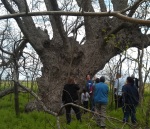
Austin’s outdoors hold many hidden gems. In particular, I just rediscovered a public place that isn’t a park or preserve per se. The Austin Water Utility owns frontage along 3.5 miles of the Colorado River’s north bank near Bergstrom Airport. The 1,200-acre Hornsby Bend Biosolids Management Plant offers a major bird observatory, manufactures Dillo Dirt compost, hosts the Center for Environmental Research, and partners with several ecologically minded organizations. Among them and headquartered in an ecohouse on the Hornsby Bend site is Austin Youth River Watch. They held a party last weekend that featured a walk though woods down by the riverside.
Fellow geographer and guide Elizabeth Welch, who directs the youth programs, is a wealth of information about the flora and fauna there as well as their cultural uses. She led us past several ponds and tall stands of wild rice to the Colorado’s edge, which had been the historic Platt Crossing. In view were violet henbit, catchweed bedstraw, variegated bull thistle, and teeny speedwell. We saw evidence of beavers and heard that otters were nearby.

At the end of the trail was the biggest pecan tree I’ve ever beheld. Leaning downstream from some ancient flood, this gargantuan being overwhelmed our little group. Six of us couldn’t have joined hands around it. On the ground were remnants of last fall’s nuts—the small native type. Still dormant, this and other Carya illinoensis will likely bud in April. The tree would have witnessed the Hornsby family’s arrival here in 1832.
In collaboration with Travis Audubon, Hornsby Bend offers frequent owl prowls at night and other birding events. The facility is open to anyone every day from dawn to dusk. The Center is accessible off FM 973, and the nature trail is at the end of Platt Lane.